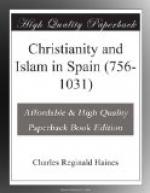[1] Murphy, “Hist. Mahom. Empire in Spain,” p. 309.
[2] Yonge, p. 60.
[3] Conde, i. 239.
[4] “Omni Christi collegio.”
[5] Alvar, “Ind. Lum.,” sec. 35.
[6] See Elipandus and Alvar
passim. Alcuin, on the other hand,
writes wonderfully good Latin.
Some sentences are so ungrammatical as to be scarcely intelligible. Moreover, we find Samson[1] directly accusing Hostegesis, Bishop of Malaga, of not being able to write Latin; and similarly Jonas of Orleans (839) accusing Claudius, Bishop of Turin, who was himself a Spaniard, of the same defect.
The neglect of Latin was accompanied by an increasing indifference to the doctrinal basis of Christianity, educated Christians being led to devote their time, which might have been more profitably spent on their own Scriptures, to becoming acquainted with the Mohammedan religion, and even to unravelling the intricacies of the controversial theology which had grown up round, and overlaid, the original simplicity of the Koran.[2] The great Fathers of the Church were laid aside unread, and even the Prophets and Apostles, and the Gospel itself, found few to study them. While the higher classes were indifferent to religion, the lower were sunk in poverty[3] and ignorance.[4] The inevitable result of this indifference, ignorance, and poverty, was a visible deterioration in the character of Spanish Christianity, of which there are only too many proofs.
[1] Samson, “Apol.,” c. vii.
[2] Alvar, “Ind. Lum.,” sec. 35—“Ac dum illorum sacramenta inquirimus, et philosophorum sectas scire non pro ipsorum convincendis erroribus sed pro elegantia leporis et locutione luculenter diserta. Quis rogo hodie solers in nostris fidelibus laicis invenitur, qui Scripturis sanctis intentus volumina quorumcunque Doctorum Latine conscripta respiciat? Quis Evangelico, quis Prophetico, quis Apostolico ustus tenetur amore? Nonne omnes iuvenes Christiani vultu decori, linguae diserti, habitu gestuque conspicui, Gentilicia eruditione praeclari, Arabico eloquio sublimati, volumina Chaldaeorum avidissime tractunt?”
[3] Florez, xix. 383, Charter
of 993; see also “Dozy,” iii. 31;
and for the condition of Christians
in the Free States, Buckle,
“Hist. of Civiliz.,”
i. 443.
[4] Dozy (l.l.).
We find the abbot Samson distinctly accusing Hostegesis, Bishop of Malaga, of simony, asserting that he sold the priesthood to low and unworthy people;[1] while Alvar charges Saul, Bishop of Cordova, with obtaining his bishopric by bribery.[2] Other irregularities imputed to Hostegesis were that he held his see from his twentieth year, contrary to the canons of the church, and that he beat priests, in order to extort money from them, till they died under his hands.
Besides the election to the priesthood, by unworthy means, of unworthy men, whose ignorance and impudence the congregation had to endure in silence,[3] many were informally ordained without vouchers for character being given, or the assent of their fellow-clergy and flocks being obtained.[4] Many churches presented the unseemly spectacle of two rival pastors, contrary to the ordinances received from the Fathers.[5]




